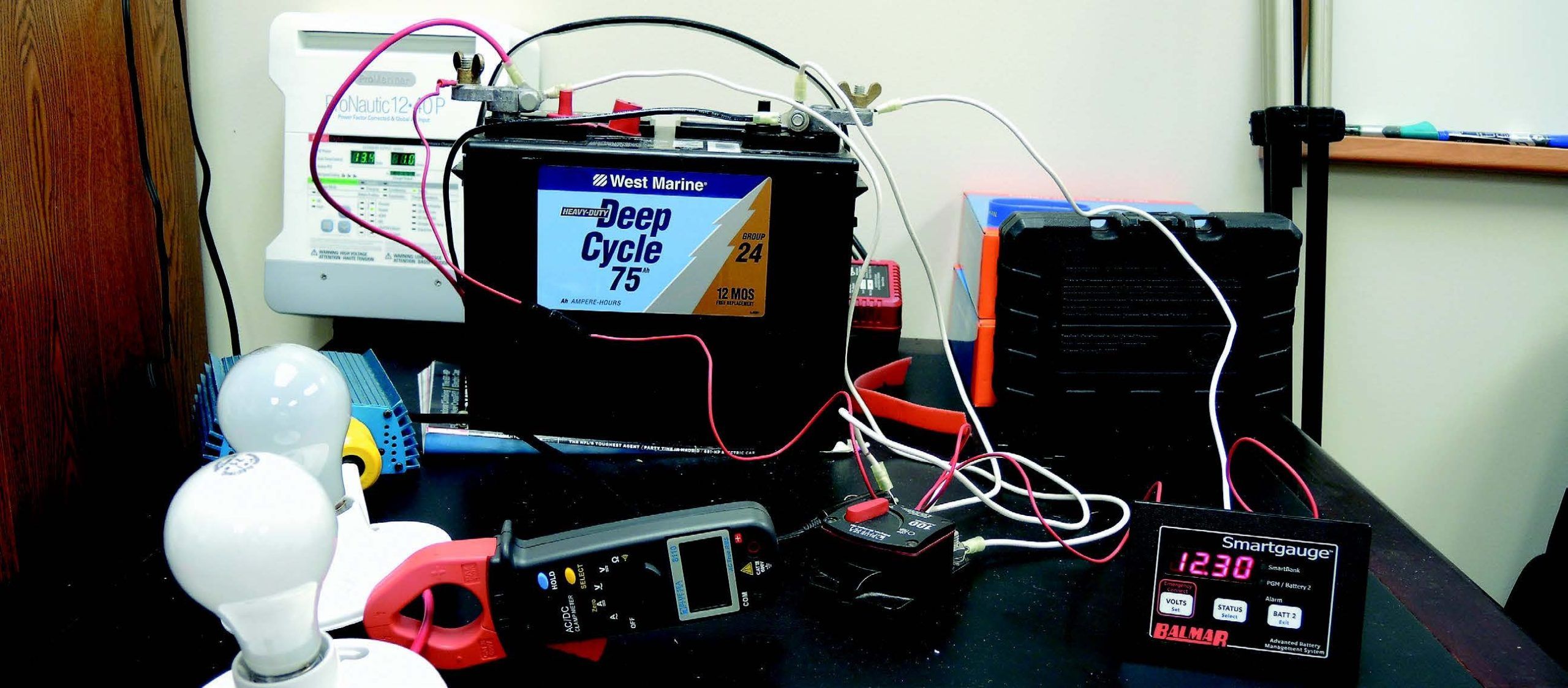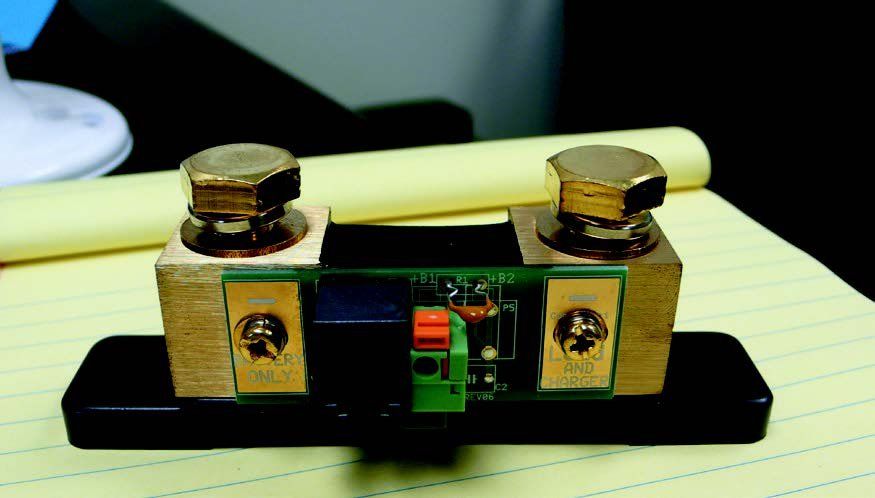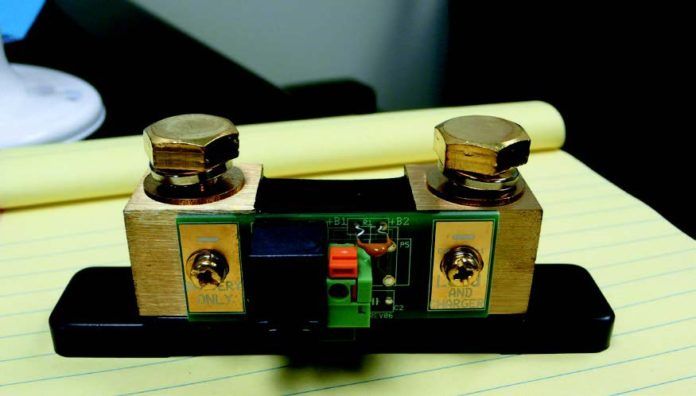Back in our October 2016 issue we looked at eight battery monitors and compared features, installation needs and overall usability. Unfortunately, we overlooked the Smartgauge made by Balmar. Thanks to our readers input we got our hands on one of these recently and ran it through the same test regimen we applied to the other eight monitors.
A brief recap of where we stand: For this report, Practical Sailor studied and compared monitoring systems from five different suppliers: Blue Sea Systems, CruzPro, Scad Technologies, Victron Energy, and Xantrex. The range was broad. At the low end was a simple, red warning-light voltage monitor from Scad that automatically shuts down heavy electrical loads or turns on a generator before the battery goes dead. At the high end was very sophisticated monitor from Victron that can work well with lithium iron phosphate (LiFePO4) battery technologies.
Of all our test units, the Victron monitors were the only ones to even mention lithium iron technology and make a recommendation for adjusting the units profiling to fit lithium technology and discharge/recharge regimens. From what we could determine, the other vendors have not really tested their products with lithium ion battery chemistry in mind.

Its important for readers to understand the limitations of any battery monitoring system. These devices are quite good at monitoring amperage and voltage and keeping track of these values down to 0.1 volts in either case. But when it comes to determining state of charge or hours of use remaining, there are many factors that can introduce some margin of error. This is something our testers had to take into account as well when they established a protocol. (See accompanying How We Tested on right for details on the testing.)
Battery chemistry and internal construction, age, temperature, and rate of discharge and recharge efficiency all play into the degree of accuracy we can expect from a battery monitor. Several of the vendors in our group have given these matters considerable attention and make recommendations to periodically synchronize or calibrate the monitor with the batteries being monitored. Victron, for example, offers an optional temperature sender to provide that data input to their monitors. Some of the vendors did not offer any guidance for calibration, presumably because calibration is limited, if at all possible.
Why does temperature matter? Monitoring battery temperature and building that data into a micro-processor that is sending out a voltage reading is useful for those seeking extreme accuracy. There is a direct correlation between temperature, current (amperage), and voltage. As batteries heat and cool due to both ambient temperature variations and electro-chemical reactions in each cell of the battery, their internal electrical resistances also vary. We know from Ohms Law that as resistance changes (mathematically) both voltage and current will change. In the case of battery monitors that essentially present a voltage reading, monitoring temperature in real time can more accurately depict voltage, and therefore, state of charge.
Why is calibration so important? As your batteries age, a re-adjustment of the charging parameters is really quite necessary in order to maximize the accuracy of your monitor. What is interesting about the Balmar Smartgauge is that it relies on smart algorithms that don’t require either a temperature gauge or operator calibration to be accurate.
Installation
Without a doubt, the Balmar unit is the simplest of all the units we have tested when it comes to installation. Since there is no shunt required for amperage measurements with the Balmar Smartgauge an entire step in the installation process is eliminated.
This unit gathers all its data directly from sensor wires connected to the positive and negative terminals of the batteries it is monitoring. That said, if the electrical connections are easier, the trickier part is the setup. Compared to some of the other monitors, you have to pay closer attention to the initial calibration that is required to ensure the monitors accuracy. Multiple battery installation wiring configuration is critical as well.
For example, battery banks must share a common ground point and cannot share a common positive connection. The meters positive and negative sense wires must be connected directly to the posts on the batteries being monitored, not remote buss bars or terminals. Doing so will impact the meters accuracy.
Also, the monitor has dedicated terminals for connection of the engine starter battery and house battery bank. This is important because the monitor gives different readings for each bank. The starting battery will simply provide a voltage reading, the house bank simply gives a state of charge (SOC) reading. Further, proper selection of battery type is critical to the accuracy of the monitor.
Balmar provides six choices and emphasizes two types of AGM technology with differing charging voltage parameters, so again, making the correct choice here is important. Also, its important for the user to realize that it will typically take two or three complete charge-discharge cycles for the monitor to learn your house battery characteristics. Balmar claims that over time the monitors accuracy will actually improve; quite the opposite over some of the other monitors we compared in October.
Notably missing in the sensing area is temperature monitoring, or at least there is no mention of it in the provided operation manual. We find this a bit odd because conventional wisdom suggests that temperature monitoring is quite important to achieving maximum accuracy. Also, no mention of Lithium battery technology is made in the monitors owners manual.

Further calibration is available for high and low voltage alarm settings, display brightness and other behaviors such as how long data is displayed before re-activation is required.
Observations
To test the Balmar Smartgauge we used the same test set-up we had in October when we tested the other eight monitors (see How We Tested on right). After running through four timed cycles bringing the battery down to what we calculated as approximately an 80 percent state of charge we compared our calculated values to the Balmar Smartgauge readings.
We found the state of charge readings to be accurate within a five percent margin of error. The variation could be due to the condition of the test battery, which is now ten months old and has gone though several discharge cycles.
In addition, because of the design of the Balmar unit, which does not use a shunt and does not actually count amp hours used, we expected a difference here. We suspect that the 5 percent disparity between our calculations and the actual state of charge and voltage readings is due to the inherent inaccuracy of our state-of-charge calculations.
Tenths of a volt count heavily in this case. Based on averages, there is only about a 0.7 to 0.9 volt delta between a fully-charged (100 percent) battery and completely discharged battery. Our hunch is that the Balmar Smartgauge was providing the more accurate reading of actual state of charge in this case. We know from experience that if you try to precisely measure battery voltage using five digital multimeters, the odds are slim that all five meters will reading exactly the same.
Conclusion
This Balmar unit certainly wins the war when it comes to actual installation ease. That part is really quite simple. The owners manual is clearly written but we must emphasize that following the calibration and pre-programming instructions to the letter is of paramount importance to ensure maximum accuracy of the data outputs. Based on the premise that this units accuracy will actually improve as it learns the habits of the specific battery it is connected to, we believe that the Balmar unit is a great choice for the cruiser who really needs to know how much battery power they have left to work with.

Three products stood out in the battery monitor test: the Victron 700 and 702, thanks to their very precise calibration and two-bank capability, and the easy-to-install Xantrex LinkPro, and the self-calibrating Smartgauge from Balmar.





































